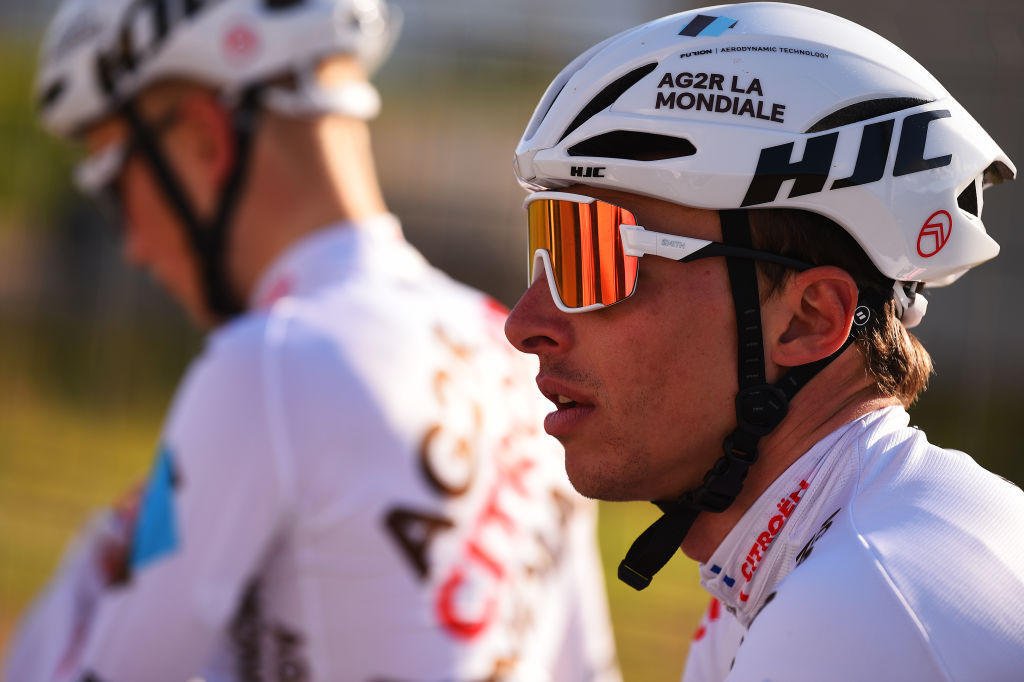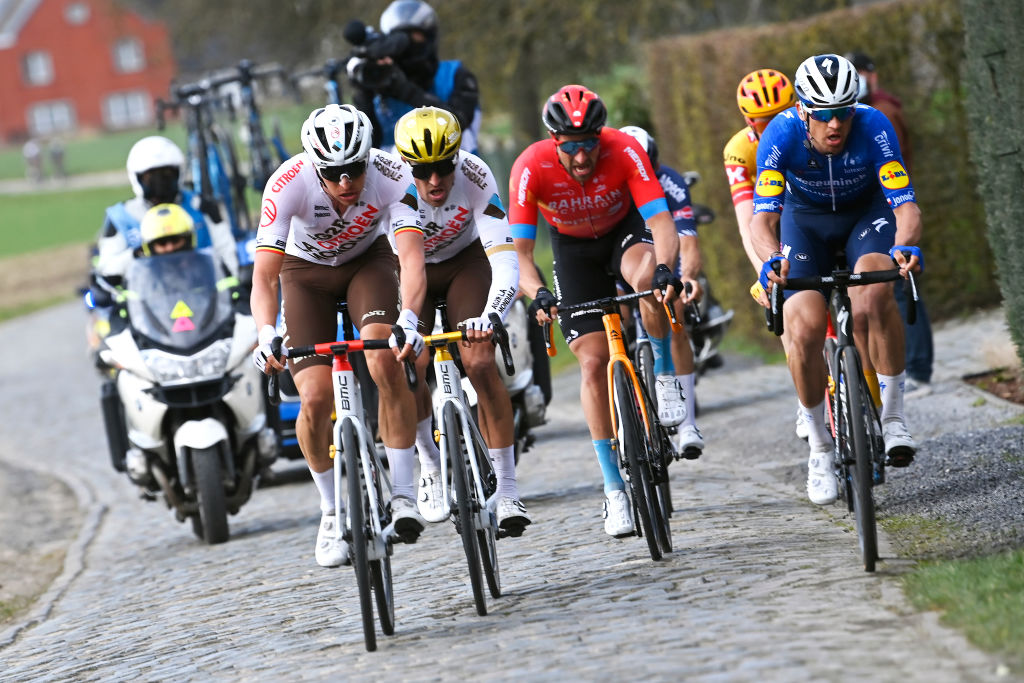Oliver Naesen in quest to remove Classics question marks
After wiping ‘easy day’ training, Belgian makes Ruta del Sol 2022 debut

After a difficult 2021 where overtraining often left him struggling to be competitive, Oliver Naesen (AG2R-Citroen) will start his 2022 season with the aim of regaining confidence and the certainty that he can be in the thick of the action when it counts. As the Belgian Classics contender puts it, it’s all about removing the question marks.
That process has thrown up some unusual consequences.
“If anything, I’m less ambitious than I used to be,” Naesen tells Cyclingnews before he makes his 2022 season debut at the Vuelta a Andalucia Ruta Ciclista Del Sol in the south of Spain.
“Other years I would always have a Spring Classics season where I’d get, I don’t know how many top five or top ten places, and I’d be, like, ‘this is really good but it doesn’t really spark much joy'.”
“Whereas now if I could get that kind of regularity back, then that would be amazing. When it was there, I didn’t appreciate the regularity was actually a really nice thing. And if I get it, I know that one day, if the planets align, then that big win will come.”
According to Naesen, the lack of freshness caused by overtraining was what left him out for the count in the first half of 2021.
“That was also what I missed last spring: freshness,” Naesen told Dutch website Wielerflits in autumn last year.
Get The Leadout Newsletter
The latest race content, interviews, features, reviews and expert buying guides, direct to your inbox!
“I trained like mad. The more the better. I've reached my limits in training volume, but I'm not getting any better.” Or as he tells Cyclingnews: “When cycling is good it’s so much fun, it’s so amazing that you get hugely rewarded for the efforts you put in. It’s just so motivating to do more and more and more, and to a certain degree you will get better and better.”
“But there’s a limit to that approach and [once that limit is passed] you go way worse because you have no energy left. And that’s what happened to me last year.”
Cue two dramatic decisions by Naesen to try and resolve this: firstly to take a lengthy break over the winter and secondly to eliminate what he calls the “coffee rides” from his regular training program.
The all-round aim of this double-pronged approach was to ‘re-set’ the counters to zero and simultaneously avoid the feeling of “mediocrity, no matter what I did” as he vividly described it, that plagued his 2021 season.
“For the first time ever I took a six week break, I’ve never done that before,” Naesen tells Cyclingnews.
“It felt really good. I was waking up fresh in the morning again, something that had never happened to me before in the entire year. Previously I’d always feel sleepy and grumpy. But luckily that time is behind me now.”
“At the same time, I noticed that when I started training again, my body was reacting well. I was progressing.”
Goodbye coffee rides
Compared to previous years, Naesen has eliminated the “easy rides” or “low quality days” from his training program.
Previously on a rest day he’d just do a couple of hours steady to spin the legs but what he found was that 'easy training' was creating fatigue with none of the benefits. Given he didn’t specially need those easy efforts to burn calories, they were of little use weight-wise too.
Inversely, after cutting back on easy training, he’s now found high quality training rides to be much more beneficial because “I wasn’t tired from riding the day before.”
Even with just a couple of hours on the bike during a rest day, due to the process of “eating and getting ready, washing the bike and taking a shower, before you know it you’ve used up half a day and you haven’t really relaxed,” Naesen explains.
While finding a balance between too much training and too little is never straightforward, even for a 31-year-old pro like Naesen, his bike riding was running his life, not the other way round.
“It felt like I had to ride every day, every day. I could not go one day without riding the bike. I had to develop a habit not to do that,” he reflected.
“Even now, I still have the urge to go out on my rest days, but luckily,” he said with a wry chuckle, "in Belgium the weather has been terrible recently so the urge was very small.“
“But in summer, say, and when it was great weather and everybody was heading off for a coffee ride, I cannot say I’d always stay home. But I knew that should be the goal. That should be the goal."
Naesen’s closest friend is former Olympic champion and AG2R-Citroën teammate Greg Van Avermaet, who experienced a similarly uneven second half of the season in 2021.
During many training sessions, the two would discuss their racing woes of 2021 in detail and how to resolve them in 2022.

With his revised training schedule and rest during the winter, Naesen is now back on track. Both he and Van Avermaet will be racing in Spain at the Vuelta a Andalucia Ruta Ciclista Del Sol, their last before the Opening Weekend in Belgium.
“I’ve not raced yet, so it’s hard to compare my form to previous years, but I feel so much fresher,” Naesen says.
“On the other hand, I’m going into the season with a pretty big question mark over my head. Will I begin to go downhill again? That’s one pretty big question.
This kind of insecurity is not a nice feeling, it’s not motivating and it makes me look forward to getting started and getting through the first race to see if I’m where I want to be.”
The Ruta del Sol will be one of Naesen’s main pre-Classics tests. The route is hilly albeit without any dramatically difficult days in the mountains. Classics riders like Zdenek Stybar and Florian Sénechal (QuickStep-AlphaVinyl), Sep Vanmarcke (Israel-Premier Tech) and Matteo Trentin (UAE Team Emirates) will all use the Spanish stage race to polish their form.
The key reference, however, for the whole Classics season, is the Opening Weekend, in particular Omloop Het Nieuwsblad.
“You have to be up there,” he said categorically, “because if not, it’s probably not going to happen later in the spring.
“The thing is with the new Omloop route of the last two or three years, if the wind is in the wrong place then it’s just a bunch sprint race, so it’s hard to read conclusions.”
“But either way, if you’re not up there in the hardest part of the race, then that’s a really bad sign for sure.”
Naesen tackles the outcome of the Opening Weekend by taking away as many positives as possible and “leaving the negative ones behind.”
“If I go badly, then I’ll try to minimise it, tell myself it’s too early and I can be good later on in the year;” he said.
But he recognises, too, that this year, Omloop would be even more significant as a personal test.
“Right now, it’s super-important. If I do great that day, then I’ll know I went down the wrong way last year and I’m back on the right path. If it goes badly, though, there will be a lot of doubts running through my mind."
Alasdair Fotheringham has been reporting on cycling since 1991. He has covered every Tour de France since 1992 bar one, as well as numerous other bike races of all shapes and sizes, ranging from the Olympic Games in 2008 to the now sadly defunct Subida a Urkiola hill climb in Spain. As well as working for Cyclingnews, he has also written for The Independent, The Guardian, ProCycling, The Express and Reuters.
